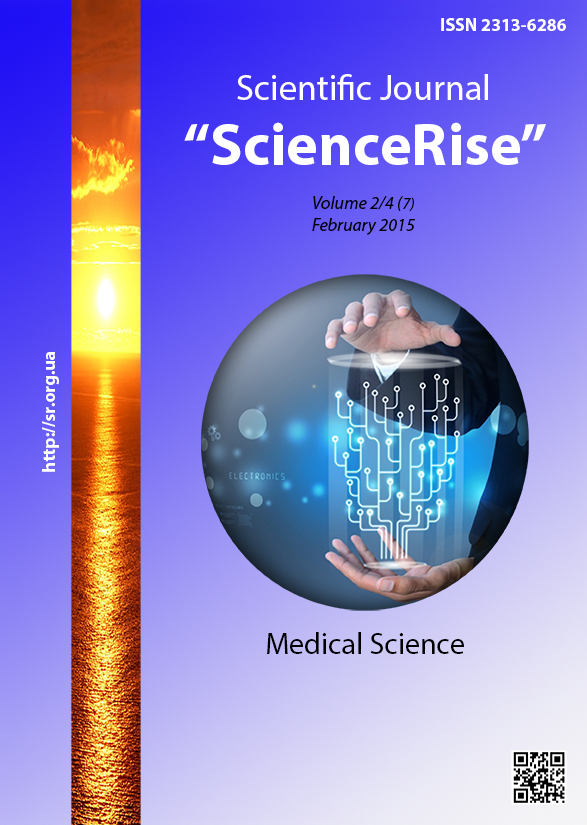Anesthetic management of endoscopic microsurgical interventions for bilateral vocal cord paralysis
DOI:
https://doi.org/10.15587/2313-8416.2015.37408Keywords:
bilateral vocal cord paralysis, laryngeal microsurgery, jet ventilation, tracheostomyAbstract
Surgical repair of bilateral vocal cord paralysis is widely considered as one of the most complicated procedures in laryngeal microsurgery. Unobstructed view of laryngeal structures and adequate amount of working space are essential prerequisites for successful microsurgical operation. In order to provide necessary surgical condition several ventilatory techniques can be employed. Available options include preventive tracheostomy, conventional ventilation via small endotracheal tubes and jet ventilation. At the same time, improvement of surgeons’ working conditions is never considered as an ultimate goal if it does not lead to better results or decrease of expenses.
Materials and methods: We report a retrospective study of 104 patients who had undergone microlaryngeal surgery for bilateral vocal cord paralysis. Duration of hospital stay, duration of surgery and time spent in the operating room were compared between the three groups of patients with different ventilation strategies.
Results: The highest duration of hospital stay was in the group of preventive tracheostomy (18,68±7,48 days), whereas in the groups of tracheal intubation and subglottic jet ventilation it was considerably lower (12,9±7,11 and 12,15±5,69 respectively).
Conclusions: Obtained data suggest that preventive tracheostomy performed prior to endoscopic microlaryngeal surgery is the major independent risk factor of prolonged hospital stay for patients with bilateral vocal cord paralysis
References
Janjević, D. et al. (2012). Subglottic high frequency jet ventilation in surgical management of bilateral vocal fold paralysis after thyroidectomy. Acta Clin Croat, 51, 451–456.
Pavlyk, B. I. (1990). Types of endoscopic chordarythenotomy for bilateral vocal cord paralysis. Kiev, USSR: Journal of ear nose and throat diseases, 3, 29–35.
Damrose, E. J. (2011). Suture laterofixation of the vocal fold for bilateral vocal fold immobility. Current Opinion in Otolaryngology & Head and Neck Surgery, 19 (6), 416–421. doi: 10.1097/moo.0b013e32834c7d15
Sapundzhiev, N. et al. (2008). Surgery of adult bilateral vocal fold paralysis in adduction: history and trends. European Archives of Oto-Rhino-Laryngology, 265 (12), 15011–514. doi: 10.1007/s00405-008-0665-1
Hashmi, N. K. et al. (2010). Quality of life and self-image in patients undergoing tracheostomy. Laryngoscope, 120 (4S), 196. doi: 10.1002/lary.21663
Baer, G. A. (2011). Endolaryngeal Procedures: Conventional Intubation vs. Infra- and Supra-glottic JV, Joined Papers on Jet Ventilation. Edited by Baer GA. Tampere, Tampere University Press, 37–42.
Dhara, S. S.; Riley, R. (Ed.) (2011). Jet Ventilation and Anaesthesia – A practical guide to understanding jet ventilation and its current applications in clinical anaesthetic practice Australasian Anaesthesia 2011.Invited papers and selected continuing education lectures, 79–92.
Hunsaker, D. H. (1994). Anesthesia for microlaryngeal surgery: the case for subglottic ventilation. Laryngoscope, 104 (8 Pt2 suppl 65), 1–30.
Kalezic, N. et al. (2013). Subglottic high frequency jet ventilation in management of bilateral vocal fold paralysis: A case report. HealthMed, 7 (4), 1262.
Samarütel, J. (2011). 20 Years of Experience with Normofrequent subglottic/intratracheal Jet Ventilation. Joined Papers on Jet Ventilation, Edited by Baer GA. Tampere, Tampere University Press, 43–44.
Davies, J. M. et al. (2009). The Hunsaker Mon-Jet tube with jet ventilation is effective for microlaryngeal surgery. Canadian Journal of Anesthesia/Journal canadien d'anesthésie, 56 (4), 284–290. doi: 10.1007/s12630-009-9057-2
Hu, A. et. al. (2012). Hunsaker Mon-Jet tube ventilation: a 15-year experience. Laryngoscope, 122 (10), 2234–2239. doi: 10.1002/lary.23491
Downloads
Published
Issue
Section
License
Copyright (c) 2015 Сергій Олександрович Дубров, Денис Олегович Покришень

This work is licensed under a Creative Commons Attribution 4.0 International License.
Our journal abides by the Creative Commons CC BY copyright rights and permissions for open access journals.
Authors, who are published in this journal, agree to the following conditions:
1. The authors reserve the right to authorship of the work and pass the first publication right of this work to the journal under the terms of a Creative Commons CC BY, which allows others to freely distribute the published research with the obligatory reference to the authors of the original work and the first publication of the work in this journal.
2. The authors have the right to conclude separate supplement agreements that relate to non-exclusive work distribution in the form in which it has been published by the journal (for example, to upload the work to the online storage of the journal or publish it as part of a monograph), provided that the reference to the first publication of the work in this journal is included.

